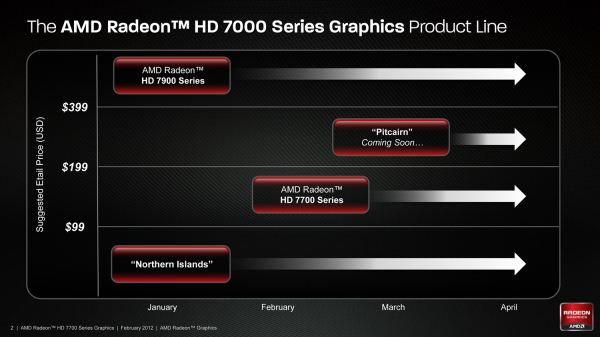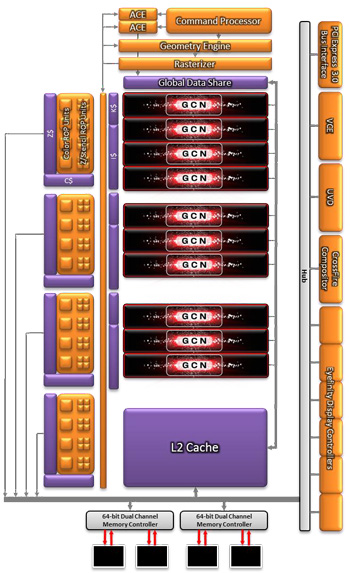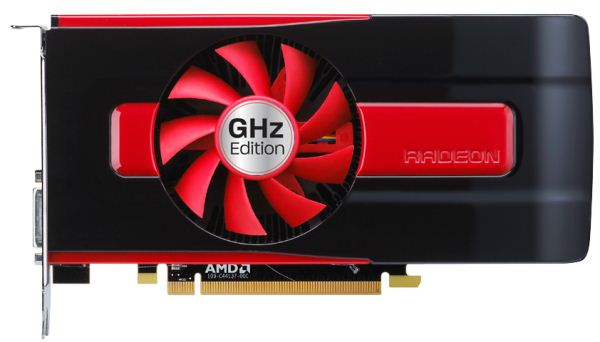AMD Radeon HD 7750 & Radeon HD 7770 GHz Edition Review: Evading The Price/Performance Curve
by Ryan Smith & Ganesh T S on February 15, 2012 12:01 AM EST- Posted in
- GPUs
- AMD
- HTPC
- GCN
- Radeon HD 7000
With the launch of Tahiti behind them, AMD is now firing on all cylinders to get the rest of their Southern Islands lineup out the door. Typically we’d see AMD launch their GPUs in descending order of performance, but this time AMD is taking a slight detour. Rather than following up the Tahiti based 7900 series with the Pitcairn based 7800 series, AMD is instead going straight to the bottom and launching the Cape Verde based 7700 series first.
Today AMD will be launching two cards based on the Cape Verde GPU: the Radeon HD 7750, and the Radeon HD 7770 GHz Edition. As the Juniper based 5700 series never got a proper Northern Islands successor, this is the first real update for the x700 series since the launch of the 5700 series in October of 2009. Given the success of the 5700 expectations are going to be high, and to fulfill those expectations AMD will be bringing to bear their new GCN architecture along with a full node jump with TSMC’s 28nm process. But will this be enough to enable the 7700 series to replicate the success of the 5700 series? Let’s find out.
| AMD GPU Specification Comparison | |||||||
| AMD Radeon HD 7770 GHz Edition | AMD Radeon HD 7750 | AMD Radeon HD 6850 | AMD Radeon HD 5770 | AMD Radeon HD 5750 | |||
| Stream Processors | 640 | 512 | 960 | 800 | 720 | ||
| Texture Units | 40 | 32 | 48 | 40 | 36 | ||
| ROPs | 16 | 16 | 32 | 16 | 16 | ||
| Core Clock | 1000MHz | 800MHz | 850MHz | 850MHz | 700MHz | ||
| Memory Clock | 4.5GHz GDDR5 | 4.5GHz GDDR5 | 4.8GHz GDDR5 | 4.8GHz GDDR5 | 4.6GHz GDDR5 | ||
| Memory Bus Width | 128-bit | 128-bit | 256-bit | 128-bit | 128-bit | ||
| Frame Buffer | 1GB | 1GB | 1GB | 1GB | 2GB | ||
| FP64 | 1/16 | 1/16 | N/A | N/A | N/A | ||
| Transistor Count | 1.5B | 1.5B | 1.7B | 1.04B | 1.04B | ||
| PowerTune Limit | 100W | 75W | N/A | N/A | N/A | ||
| Manufacturing Process | TSMC 28nm | TSMC 28nm | TSMC 40nm | TSMC 40nm | TSMC 40nm | ||
| Architecture | GCN | GCN | VLIW5 | VLIW5 | VLIW5 | ||
| Price Point | $159 | $109 | ~$149 | ~$99 | ~$89 | ||
With the 6000 series AMD effectively had a 5 chip stack: Caicos (6400), Turks (6600), the rebadged Juniper (6700), Barts (6800), and Cayman (6900). Since then integrated GPUs have effectively wiped out the low end of the market, and by the time Trinity launches later this year any product short of 6600 performance should be made redundant. As a result AMD has reigned in on their spread out stacks, leading to their 28nm Southern Islands product stack being just 3 products: Cape Verde (7700), Pitcairn (7800), and Tahiti (7900). Anything below the 7700 series will be rebadged Northern Islands parts, primarily Turks and Caicos.
But AMD’s product stack doesn’t tell the whole story. AMD will need to cover a wide range of products and price levels with only 3 GPUs, ranging from $109 to $550. As a result the performance levels of AMD’s various product series are being redefined somewhat, and nowhere is this more apparent right now than with the 7700 series. Why do we say that? Well let’s take a look at the specs and pricing.
Cape Verde, the GPU at the heart of the 7700 series, is AMD’s smallest 28nm GPU. With a die size of 123mm2 it’s only a hair bigger than the 118mm2 Turks GPU that powers the 6600 series. In terms of functional units we’re looking at 10 Compute Units, giving Cape Verde 640 SPs and 40 texture units. Elsewhere Cape Verde packs 16 ROPs, 1 geometry engine/rasterizer pair, and 512KB of L2 cache, with the chip coupled to a 128bit GDDR5 memory bus. Altogether compared to Tahiti this is around 31% of the CUs, 33% of the memory bus width, and half as many ROPs.
Interestingly, unlike Tahiti, Cape Verde’s CUs are organized slightly differently. GCN is designed around 4 CUs in each CU Array, with the 4 CUs sharing a read-only L1 instruction cache and a read-only L1 data cache. This is how both the 7970 and 7950 are organized, with the 7950 simply lopping off a whole CU array. However with Cape Verde 10 CUs doesn’t cleanly divide into groups of 4, so for the first time AMD has built something a bit different. In Cape Verde there are 3 CU arrays, populated in a 4/3/3 manner. With regards to performance there shouldn’t be a huge difference, but this does mean that there’s a bit less cache pressure on the CUs occupying the smaller CU arrays.
On the functionality side of things, backing up Cape Verde will be the rest of the Southern Islands family features we’ve already seen on Tahiti, such as DX10+ SSAA, PowerTune, Fast HDMI support, partially resident textures, D3D 11.1 support, and the still-AWOL Video Codec Engine (VCE). Even FP64 support is accounted for, however similar to how NVIDIA handles it on lower-end parts it’s a performance-limited implementation for compatibility and software development purposes, with FP64 performance limited to 1/16th FP32 performance.
As for the cards themselves, AMD will be releasing two Cape Verde cards: the Radeon HD 7750, and the Radeon HD 7770 GHz Edition. The 7770 will be a fully enabled Cape Verde with all 10 CUs (640 SPs) enabled, running at 1GHz for the core clock and 4.5GHz for the memory clock, with a PowerTune limit of 100W and an AMD defined typical board power of 80W. The 7750 meanwhile has 2 disabled CUs, giving it 512 SPs and 32 texture units, while the ROP count is unchanged at 16. The core clock will be 800MHz while the memory clock is the same as the 7770 at 4.5GHz, with a PowerTune limit of 75W and a typical board power of 55W. Both cards have a sub-10W idle TDP, while long-idle is sub-3W.
With those specs in mind, it’s interesting to note that the difference between the 7750 and 7770 is much wider than we’ve seen in past products. Compared to the 7750, the 7770 has 25% more CUs and a 25% core clock advantage, giving it a massive 56% shader and texture performance advantage over the 7750. With the 5700 series this gap was only 35%, and most of that was a result of core clock differences. The fact that the memory bandwidth is the same between the 7770 and 7750 equalizes things somewhat, but it’s still a huge difference for two cards that are in the same family.
This brings us back to where we started: how AMD is covering the entire $109+ market with only 3 GPUs. Between the massive performance gap between the 7700 series cards and the fact that the 7750 is a sub-75W part, it becomes increasingly obvious that the 7700 series is the de-facto replacement for both the 6600 series and the 5700 series. The 7750 will fill the 6670’s old role as AMD’s top sub-75W card, but as we’ll see its performance means it won’t be a complete replacement for the 5700 series. Instead the role of replacing the 5700 series falls to the much more powerful 7770.
As for today’s launch, AMD will be launching the 7750 at $109 and the 7770 at $159, which happens to be the same prices the 5770 and 5750 512MB launched at respectively. With midrange cards there usually aren’t any supply issues and we aren’t expecting the 7700 series launch to be any different, however as is customary AMD’s partners will be launching semi-custom cards from day one, so pricing will probably be inconsistent.
At these prices the 7700 series will be competing with a number of last-generation cards. The 7750 will be up against AMD’s 5770/6770 and the absolute cheapest of NVIDIA’s GTX 550 Ti cards. Meanwhile the 7770 will be competing with AMD’s 6850 and 6870, along with NVIDIA’s GTX 460 and their cheapest GTX 560s. And as we’ll see in our benchmarks, this is ultimately going to be more than the 7700 series can handle.
| Winter 2011/2012 GPU Pricing Comparison | |||||
| AMD | Price | NVIDIA | |||
| $209 | GeForce GTX 560 Ti | ||||
| $179 | GeForce GTX 560 | ||||
| Radeon HD 6870 | $169 | ||||
| Radeon HD 7770 | $159 | ||||
| Radeon HD 6850 | $139 | ||||
| $119 | GeForce GTX 550 Ti | ||||
| Radeon HD 7750 | $109 | ||||
| Radeon HD 6770 | $99 | ||||













155 Comments
View All Comments
bazinga77 - Wednesday, February 15, 2012 - link
here is the thing to be honest. if you complain about the price that seems like a fair complaint. however one has to wonder how much it costs amd and nvidia in losses to keep dropping prices to stay competitive. at some point it has to catch up with you. with the losses amd has suffered with bulldozer they have to be smarter with the prices. also until nvidia launches something new they can stay a little heavy handed with the prices unless nvidia forces the issue especially as we see some of the older cards go away and amd has said that the 6xxx series cards are no longer in production and haven't been for months. so right now the pricing seems a little bit off but what about once you can't get a 6850,6870, of gtx 460 ti? it will make more sense then.finally if you expected a 77xx series card to blow anything out of the water with its limited memory bandwidth of 128 bit memory then frankly you are either not very intelligent or naive. this is a lower mid ranged card that almost beats last gens upper mid range card. that is not bad. this card was never going to blow the roof off and if you thought it could will that just wasn't the best thought process you ever had.
Markstar - Wednesday, February 15, 2012 - link
I'm sorry, but you entirely missing the point of the whole concept of the IT industry. Graphic cards are not groceries, where you are lucky if you can still buy them for the same price 18 months later. The desktop market is declining, so there are plenty of computers out there fast enough to run Firefox and Word.There HAS to be an incentive to buy new parts - and especially now that integrated graphics are fast enough for 1080p and casual games, this HAS to involve a performance gain in some form or another to get people to buy a dedicated graphic card, let alone upgrade from their existing one.
Who is going to buy this card? Seriously, who? A person who is tight on money should look on Ebay, where you get a used 5770/6770 for $60. Everyone else is bettor off buying the 6850 or going to NVidia.
Frankly, you are a bit naive if you think we will applaud AMD for releasing such an underachiever. As it stand now, AMD would have been better off with another round of rebadging (thereby saving money on R&D and freeing up 28nm wavers).
Sad, very sad. :(
bazinga77 - Wednesday, February 15, 2012 - link
integrated graphics aren't good enough to run most games. if by casual games you mean angry birds then i guess i would agree with that.most gpu's come out higher in price initially then we expect or want especially when newer cards come out while the other vendor, in this case nvidia, is a ways away from releasing there next gen cards. sure we can bash this card but to do so we have to assume nvidia is going to blow amd out of the water. sure amd has been rebranding their cards the last two cycles but nvidia is more guilty of that then anyone. so as the current market stands the price is a little high. but lets be honest it is only looking that way because cards like the 6850 are still available, which won't be the case in the very near future.
i guess if you want to buy a used gpu off of ebay with no warranty then someone can do that and if it craps out in a month then they can deal with that as well. and if someone is tight on money and only going to spend $60 then i doubt they are on a site like this and care about benchmarks let alone at 1080p etc.
the gtx 460 is becoming harder and harder to find and the gtx 560 is over $200 so i don't see a huge issue. i expect the cards to lower in price next month when the 7850 launches and the 7770 will settle down into a more comfortable range. if you buy a gpu or cpu day one you will always pay more typically then a couple of months later.
i don't think amd should be applauded but i think people need to be realistic. when nvidia released the 550 ti it didn't even get close to the gtx 460 ti, yet that is the exact thing amd is getting bashed for. the 550 ti competes with the 6770 and 6790, while the 6850 was trying to get closer to competing with the gtx 560 and gtx 460. like i said the 550 ti didn't perform better than the gtx 460, not even close, yet you expect amd to release a card that would typically compete against a card like the 550 ti (in its respected generation, being the next nvidia card that would replace the 550 ti) and you expect it to compete at a higher class than it is released. sure the price isn't perfect but you are expecting a civic released to compete with a corolla to actually compete with bmw 1 series.
bhima - Wednesday, February 15, 2012 - link
Uhh... its really not hard to find a GTX560 for under $200.$170 : http://www.newegg.com/Product/Product.aspx?Item=N8...
$175: http://www.newegg.com/Product/Product.aspx?Item=N8...
$185: http://www.newegg.com/Product/Product.aspx?Item=N8...
We expect the card to compete with this because its priced a bit higher than this old tech:
HIS ICEQ 6870 $170: http://www.newegg.com/Product/Product.aspx?Item=N8...
chizow - Wednesday, February 15, 2012 - link
Great points Markstar, I'm glad there's others who understand the issus with the 7-series pricing many people have.TerdFerguson - Wednesday, February 15, 2012 - link
Thanks for the honest review. AMD deserves to be dragged through the coals for trying to sell us something that costs more and performs worse than a two-year-old card. This constitutes an epic failure in the world of consumer electronics. The more you stress it, the more it feels like you're an advocate of the consumer and not the greedy corporate suits.Bull Dog - Wednesday, February 15, 2012 - link
On VCE and the Test page, "7700 series launch is a bit more unsettling. These are cards that are going to be paired with slower GPUs, where having a high speed H.264 encoder is going to be all the more important."I believe it should be CPU and not GPU there.
pandemonium - Wednesday, February 15, 2012 - link
I think it's pretty obvious that AMD is milking what they can while the buzz of the architecture and die size is fresh - primary opponent being absent in their next series release and all. In a month it'll be a different story. Prices will have settled in to where they belong after all the manufacturer's have their versions readily available. I don't really see how this is a big deal. Has any card released been placed appropriately immediately at debut?kevith - Wednesday, February 15, 2012 - link
I am the lucky owner of a XFX HD4770.It´s fairly ok for my use, music production and occasional gaming.
I would like something a bit newer though, that can handle new games in full HD.
And now I have witnessed the launch of 5750/70, 6750/70 and now 7750/70. The 5770 being "the peoples champ" for quite a while, as my 4770 could and would have been in its time, if it wasn´t for availability problems. (Probably created by AMD on purpose, realizing, that the card was to cheap.)
But as far as I can read everywhere, the 6770 is simply another 5770. And the 5770 wouldn´t really give me a significant improvement over my 4770. Never mind DX11 and Eyefinity and all that jazz.
SO. Where should I go for a difference I can feel and see right away? 6870? Prices doesn´t give ANY clue anymore, as Anandtech pointed out with this - and previous articles.
I look at Tom´s "Best card for the money..." round-ups, but I don´t get much wiser.
It sure is a jungle out there...
silverblue - Wednesday, February 15, 2012 - link
The 4770 was far too similar in performance to the 4830 it was replacing. The 4770 was more of a test for 40nm manufacturing than anything else.The 6850 and 6870 are definitely worthy of the cash.